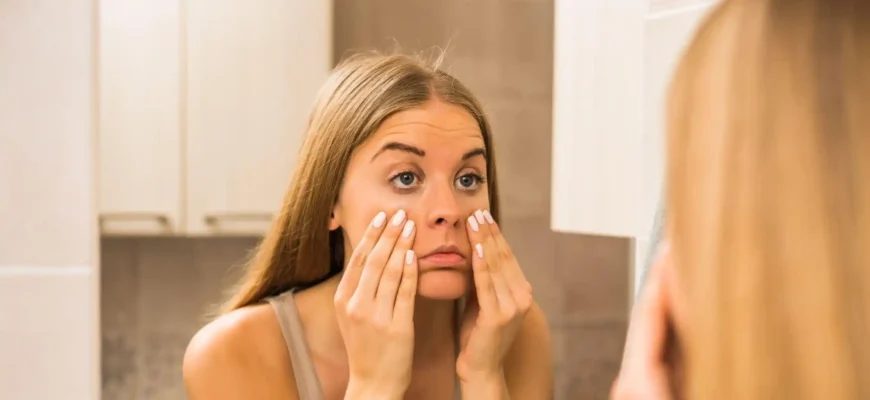Dark circles under the eyes are a common, though often misunderstood, issue. They appear as a shadowy discoloration beneath the eyes and can make even the most rested person look tired, stressed, or older than they feel. Whether you’re a 20-something living through late nights at work or a 50+ individual dealing with the natural aging process, dark circles can appear for various reasons. Thankfully, there are practical ways to address them. In this guide, we’ll take a deep dive into the science, potential causes, and effective treatments to help you look your best—without hiding behind makeup or expensive creams.
The Causes of Dark Circles
Dark circles are often more than just a cosmetic issue. Their underlying causes can be multifaceted, ranging from lifestyle factors to genetics and medical conditions. Here’s a breakdown:
- Genetics and Heredity
If you’ve got dark circles, you might have inherited them. The skin under the eyes is naturally thinner, which can make blood vessels more visible. Additionally, some people have a genetic predisposition to produce more melanin around the eyes, leading to pigmentation changes. For these cases, it’s often difficult to completely eliminate dark circles without medical intervention. - Lack of Sleep
It’s no secret that insufficient sleep leads to tired-looking eyes. When you don’t get enough rest, blood vessels under the skin dilate, causing a dark, bluish hue. Moreover, sleep deprivation leads to the release of stress hormones like cortisol, which can weaken the skin’s elasticity and further exacerbate puffiness and dark circles. - Aging
As we age, the skin loses collagen and becomes thinner. This makes the blood vessels underneath more visible, leading to the appearance of dark circles. Additionally, as the fat pads around the eyes shrink with age, they create a hollow appearance, which can also cast shadows and emphasize the discoloration. - Allergies and Nasal Congestion
Allergies can cause inflammation and dilated blood vessels, which may lead to puffiness and dark circles. Sinus congestion also contributes by slowing down circulation, making the dark circles more pronounced. If you’re constantly rubbing your eyes or dealing with itchy, watery eyes, allergies might be a significant culprit. - Dehydration
When you don’t drink enough water, the skin under your eyes becomes dry and dull, making the veins more visible. This dehydration can make dark circles appear darker and more prominent. Keeping your body well-hydrated is an easy yet often overlooked solution. - Lifestyle Factors
Smoking, excessive alcohol consumption, and a poor diet can all contribute to the development of dark circles. Smoking accelerates skin aging by damaging collagen, while alcohol dehydrates the skin, exacerbating the appearance of dark circles. A diet low in nutrients, especially vitamins C and K, can weaken the skin and blood vessels around the eyes. - Medical Conditions
In some cases, dark circles may be a symptom of an underlying health issue such as anemia, thyroid problems, or kidney disease. If the circles are persistent and unresponsive to lifestyle changes or topical treatments, it might be worth consulting a doctor for further investigation.
Solutions for Dark Circles
Now that we understand the causes of dark circles, let’s talk about practical, science-backed ways to treat and reduce their appearance.
1. Good Sleep Hygiene
It sounds obvious, but getting enough quality sleep is one of the most effective ways to reduce dark circles. Aim for 7–9 hours per night. Create a consistent bedtime routine, and avoid using electronic devices before sleep, as the blue light can interfere with your body’s natural circadian rhythm.
2. Cold Compresses and Tea Bags
One of the simplest and most affordable methods to reduce the appearance of dark circles is using a cold compress. The cool temperature helps constrict blood vessels, reducing swelling and darkening. Try chilled cucumber slices, a cool spoon, or tea bags that contain caffeine (such as green tea) to help reduce puffiness and improve circulation.
3. Topical Treatments with Caffeine, Retinol, or Vitamin C
Several over-the-counter products have proven to help diminish the appearance of dark circles. Caffeine helps constrict blood vessels, reducing puffiness and redness. Retinol boosts collagen production and can thicken the skin, reducing the visibility of blood vessels. Vitamin C brightens and strengthens the skin, making it more resilient and less prone to dark circles. However, use these products with caution, as some ingredients can be irritating.
4. Chemical Peels and Laser Treatments
For more stubborn pigmentation, dermatologists can offer chemical peels or laser treatments. Chemical peels work by removing dead skin cells, stimulating new cell growth, and lightening dark pigmentation. Laser treatments, like fractional CO2 or pulsed dye lasers, target blood vessels beneath the skin to reduce discoloration.
5. Filler Injections
For individuals whose dark circles are caused by volume loss or hollowness around the eyes, injectable dermal fillers can restore volume, reduce shadows, and smooth the skin. This treatment is particularly useful for those experiencing aging-related dark circles. However, it’s essential to consult with a qualified medical professional to avoid over-correction or complications.
6. Hydration and Healthy Diet
Maintaining good hydration and a balanced diet can have a significant impact. Drinking plenty of water keeps the skin under your eyes plump and smooth, while a diet rich in vitamins, especially vitamins C, K, and E, helps improve circulation and skin health. Dark leafy greens, berries, and citrus fruits can support the skin’s resilience and reduce puffiness.
7. Concealers and Makeup Techniques
While not a permanent solution, makeup can work wonders for covering up dark circles. A good color-correcting concealer can neutralize the blue/purple undertones, and choosing one with a hydrating formula can prevent further dryness. Make sure to blend well, and consider using a lighter shade of foundation to brighten the area. Just remember, makeup is temporary—but it’s a reliable option in the short term.
When to Seek Professional Help
While most cases of dark circles can be managed with lifestyle adjustments and at-home treatments, there are times when it’s advisable to consult a healthcare professional:
- Persistent dark circles that don’t respond to typical remedies may signal an underlying health condition such as anemia, allergies, or thyroid issues.
- Severe puffiness or swelling, especially in combination with dark circles, could be due to sinus problems or kidney function.
- Filler injections or surgery may be an option for those looking for a more permanent solution due to volume loss or structural issues around the eyes.
User Opinions
- Sarah, 32, USA (Female)
“I’ve always had dark circles, but after learning that they could be related to my diet and hydration, I made an effort to drink more water and eat more vegetables. It’s not a miracle cure, but I’ve noticed a definite improvement. And I still rely on some concealer for special occasions!” - Tarek, 45, Egypt (Male)
“I’ve had dark circles for as long as I can remember, and I thought there was no hope. But after seeing a dermatologist, I started using a retinol-based cream, and it really helped reduce the appearance. The combination of retinol and better sleep made a noticeable difference.” - Maya, 27, UK (Female)
“As a night owl, I’ve struggled with dark circles for years. A cold compress in the mornings has been a game changer. It’s refreshing, and my eyes don’t look as tired as they used to. I’ve also tried a caffeine-based eye cream, and that helps too!” - Juan, 55, Mexico (Male)
“I’ve tried everything, from cucumber slices to fancy eye creams. The only thing that worked for me was fillers. I was hesitant at first, but my dermatologist explained the whole process. It was worth it for the long-term results.” - Kita, 65, Japan (Female)
“I’ve noticed my dark circles more as I’ve aged. I try to maintain a healthy diet with lots of fruits and vegetables, and I make sure to sleep well. The difference has been subtle but helpful. And I find that a good concealer does wonders when I want to look more rested.”
In conclusion, dark circles are a complex issue that requires a holistic approach to treat effectively. Whether they stem from lifestyle choices, genetics, or aging, there are numerous options available—from home remedies and skincare treatments to professional interventions. Remember, consistency is key, and results can take time. So be patient and proactive about caring for your skin, and soon enough, you might just say goodbye to those pesky dark circles for good!









